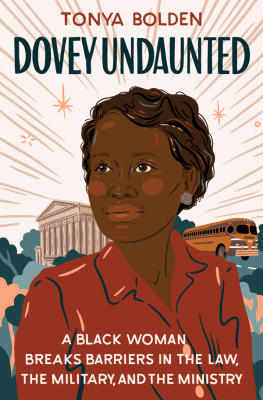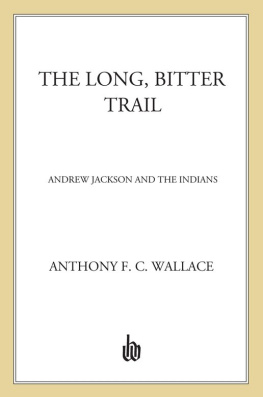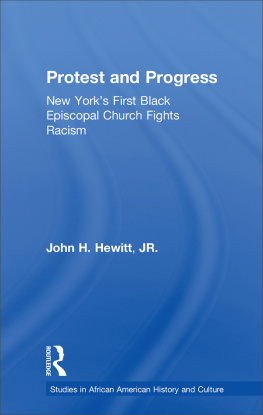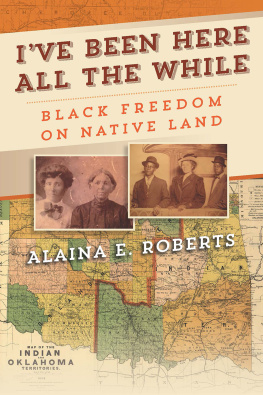The background of the cover shows a mid-18th century photo where a group of people poses for the picture in front of a huge church building. The front row shows seven people sitting on chairs while the others stand behind.
Black Indians and Freedmen
Black Indians and Freedmen
The African Methodist Episcopal Church and Indigenous Americans, 18161916
christina dickerson-cousin
2021 by the Board of Trustees of the University of Illinois
All rights reserved
Library of Congress Cataloging-in-Publication Data
Names: Dickerson, Christina, author.
Title: Black Indians and freedmen: the African Methodist Episcopal church and indigenous Americans, 18161916 / Christina Dickerson-Cousin.
Description: Urbana, Chicago: University of Illinois Press, [2021] | Includes bibliographical references and index.
Identifiers: LCCN 2021031554 (print) | LCCN 2021031555 (ebook) | ISBN 9780252044212 (hardback : acid-free paper) | ISBN 9780252086250 (paperback) | ISBN 9780252053177 (ebook)
Subjects: LCSH: African Methodist Episcopal Church MissionsHistory. | Church membershipHistory. | Indians of North America.
Classification: LCC BV2551 .D53 2021 (print) | LCC BV2551 (ebook) | DDC 287/.83dc23
LC record available at https://lccn.loc.gov/2021031554
LC ebook record available at https://lccn.loc.gov/2021031555
To my husband, Steven,
and to my sons, Steven and Samuel
Contents
- Ham Began to Evangelize Japheth:
The Birth of African Methodism in Indian Territory - Conferences, Churches, Schools, and Publications:
Creating an AME Church Infrastructure in Indian Territory - All the Rights of Citizens:
African Methodists and the Dawes Commission
Preface
This project began in 2004, shortly after I graduated from Spelman College in Atlanta, Georgia, with a BA in history. That summer, I began working as a research assistant in the Department of Research and Scholarship of the African Methodist Episcopal (AME) Church. While examining microfilm of the Christian Recorder, the official newspaper of the AME Church, I noticed numerous references to the Indian Mission Annual Conference in Indian Territory. I studied Indigenous history at Spelman, but I was unaware that the historically Black denomination to which I belonged had close ties to Native people. In 2007, I published a short article about my initial findings in the A.M.E. Church Review, the denominations scholarly periodical. Over the ensuing years, I continued to gather more information. In 2015, I traveled to Oklahoma City, Oklahoma, where I did extensive interviews with Dr. Lonnie Johnson Sr., a retired presiding elder in the AME Church whose ancestors were pioneers in the Indian Mission Annual Conference. He and his family took me to Boggy Depot, Atoka, and other locations relevant to the subject.
It has taken from 2004 until today, 2021, to complete this work. In that time, I earned a PhD in history from Vanderbilt University in Nashville, Tennessee, I married my beloved husband, Rev. Steven Anthony Cousin Jr., and I had two beautiful sons, Steven Anthony Cousin III and Samuel Philip Allen Cousin. This book shaped a very special period of my life. I present it now, hoping that it both illuminates an unappreciated aspect of AME history and raises more exciting questions.
Portions of ).
Portions of are adapted from my article Triangular Integration in a Black Denomination. I want to thank the General Commission on Archives and History of the United Methodist Church for allowing me to use this material. Triangular Integration in a Black Denomination: James Sisson, African Methodism, and the Indian Mission Annual Conference was originally published in Methodist History 53, no. 3 (2015): 13351.
Acknowledgments
Many people have supported this project. The late Dr. Lonnie Johnson Sr., the late Gracie M. Johnson, Lonnie Johnson Jr., and Donna Renee Johnson Rhodes welcomed me into their home in Oklahoma City in 2015. They provided me with information that I could not have gained elsewhere. Professor Kenneth M. Hamilton of Southern Methodist University, Professor Reginald F. Hildebrand of the University of North Carolina (retired), Professor Bernard E. Powers Jr. of the College of Charleston, and Professor Brandi C. Brimmer of the University of North Carolina have served as significant mentors whose guidance has proven invaluable.
James Engelhardt was the first acquisitions editor with whom I worked at the University of Illinois Press. He believed in the project from its earliest stages and guided it through the revision and peer-review process. Alison Syring Bassford, my current editor at the University of Illinois Press, has expertly guided the project through the final stages of the publication process.
Rev. Alfred T. Day III, the former general secretary of the General Commission on Archives and History (GCAH) for the United Methodist Church, offered crucial support for this project. During his tenure as general secretary, the GCAH provided me with a Racial/Ethnic History Research Grant that funded my trip to Oklahoma City in 2015. The American Historical Association awarded me an Albert J. Beveridge Grant that funded my trip to the National Archives in Washington, DC, that same year. I also want to acknowledge the staff at the Oklahoma Historical Society and the National Archives for their assistance. Additionally, I owe a debt of gratitude to Sean G. Smith at the Boston University School of Theology Library for digging into the archives and retrieving a rare document by John T. Jenifer that proved vital to my research.
Most of all, I want to thank my family for their unyielding love and support. My husband, Rev. Steven Anthony Cousin Jr., has never wavered in his belief in me, and our sons, Steven Anthony Cousin III and Samuel Philip Allen Cousin, have provided me additional motivation to persevere through this process. My father, Dennis C. Dickerson, PhD, encouraged me to pursue this project, read numerous drafts, and offered valuable feedback. My mother, Mrs. Mary Anne Eubanks Dickerson, has supported me every step of the way. So too have my siblings, Nicole Dickerson Kinnard, Valerie Dickerson Cordero, and Dennis C. Dickerson Jr.
A Note on Terminology
All terms are imprecise, but they are necessary for the sake of clarity. I use the terms Indigenous, Native, and Indian to describe the descendants of the first inhabitants of North America. Throughout the book, these terms refer specifically to Wyandotte, Seneca, Oneida, Ojibwe, and Pottawatomi people as well as members of the so-called Five Civilized Tribes (Cherokee, Creek, Choctaw, Chickasaw, Seminole).
I use the term Black Indian to describe people of African heritage who were enslaved by the Five Civilized Tribes. This term also refers to their descendants. Black Indians were immersed in Native cultures and sometimes had blended Indigenous and African ancestry. After the Civil War, the Five Civilized Tribes were forced to emancipate their enslaved population of roughly ten thousand people and adopt them into their tribes (the Cherokee technically freed their enslaved population in 1863, two years before the war ended). Thereafter, Black Indians also became known as freedmen, a term that was also a legal designation. I use the term







